Forgotten Characters from Forest History: "Woody"
Everyone knows Smokey Bear, Woodsy Owl, and maybe even Ranger Rick Raccoon, but there are many other forest and forestry-related fictional characters that long ago fell by the wayside. We here at Peeling Back the Bark would like to shed some light on a few of these forgotten characters, discussing their place in forest history and showcasing them to modern audiences.
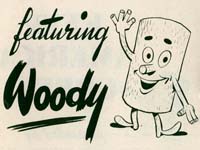 One such forgotten character is Woody, a walking, talking log of wood who first came about through a forest products industry public relations campaign during the early 1940s. The creation of Woody is credited to American Forest Products Industries (AFPI) – an organization created in 1932 as a trade promotion subsidiary of the National Lumber Manufacturers’ Association (in later years AFPI would be renamed the American Forest Institute and would go on to become part of the American Forest & Paper Association in 1992). The main role of AFPI was to fund and distribute research and promotional projects relating to lumber and other wood products industries. In 1941, in response to negative public opinion about forest industries as well as the threat of federal regulation, a formal “Forest Industries Public Relations Program” was launched under the guidance of AFPI’s Public Relations Committee.
One such forgotten character is Woody, a walking, talking log of wood who first came about through a forest products industry public relations campaign during the early 1940s. The creation of Woody is credited to American Forest Products Industries (AFPI) – an organization created in 1932 as a trade promotion subsidiary of the National Lumber Manufacturers’ Association (in later years AFPI would be renamed the American Forest Institute and would go on to become part of the American Forest & Paper Association in 1992). The main role of AFPI was to fund and distribute research and promotional projects relating to lumber and other wood products industries. In 1941, in response to negative public opinion about forest industries as well as the threat of federal regulation, a formal “Forest Industries Public Relations Program” was launched under the guidance of AFPI’s Public Relations Committee.
One of the first tasks for this new public relations program was to design various forest products advertising campaigns. These ready-made ads were designed for use in newspapers and allowed forest products companies to provide educational messages to their local communities. The first ads began circulating in 1942, carrying messages about the importance of forests as a natural resource. In 1944 a character named “Woody” first appeared in the AFPI advertising campaign. This log of wood with arms and legs proved to be immensely popular, and continued to be added to subsequent editions of AFPI advertisement books.
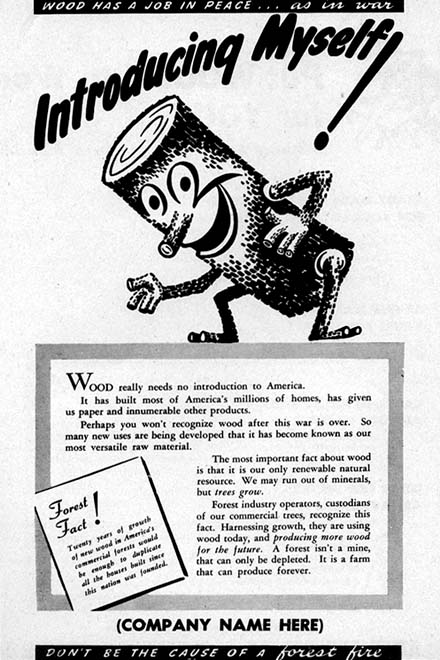
A 1944 press release from AFPI announced the debut of the Woody character, describing him as “a smiling, animated log.” As part of an industry-wide public information campaign Woody served as a symbol of forest products, good forestry, managed woodlands, tree farming, and more. Because of the time period, many of the Woody ads from this first series included wartime tie-ins.

After the war Woody evolved into a figure of forest fire prevention, and later became a symbol of the national Keep Green Movement.  The American Forest Institute formed a national Keep America Green program in 1944, and began using the Woody character as part of this campaign (see image at right of the stamp used on AFPI outgoing mail beginning in the late 1940s). Woody appeared on Keep America Green publications, promotional items (including placemats), and road signs. His work for the Keep Green program pushed Woody to the apex of his popularity. During the 1950s he made numerous live-action appearances at events, was featured on Christmas cards, and even had his own comic books.
The American Forest Institute formed a national Keep America Green program in 1944, and began using the Woody character as part of this campaign (see image at right of the stamp used on AFPI outgoing mail beginning in the late 1940s). Woody appeared on Keep America Green publications, promotional items (including placemats), and road signs. His work for the Keep Green program pushed Woody to the apex of his popularity. During the 1950s he made numerous live-action appearances at events, was featured on Christmas cards, and even had his own comic books.
All good things come to an end, though, and Woody’s time on top proved to be relatively short-lived. Over time, other characters began to overshadow the lovable log. The immense popularity of Smokey Bear as the dominant symbol of fire suppression caused Woody to ultimately fade into obscurity. In tribute, here are just a few of our favorite ads and images of Woody, an important yet forgotten character of forest history:

A Woody fire prevention poster.

Woody posing with Santa in a Portland, Oregon department store.
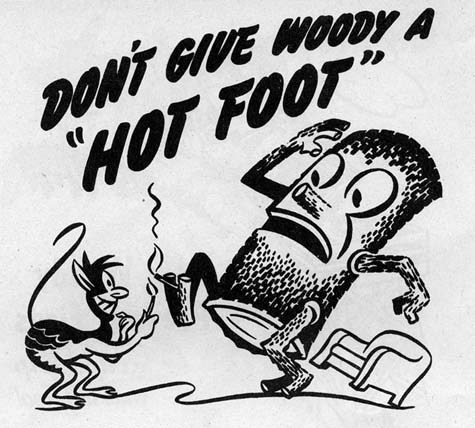
A Woody fire prevention advertisement.
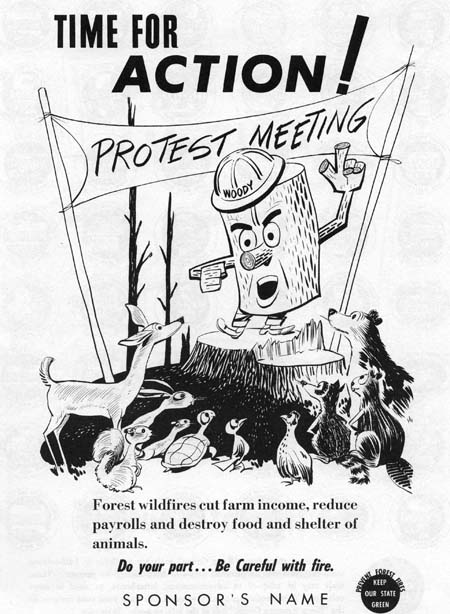
One of the Woody “Keep Green” campaign advertisements.
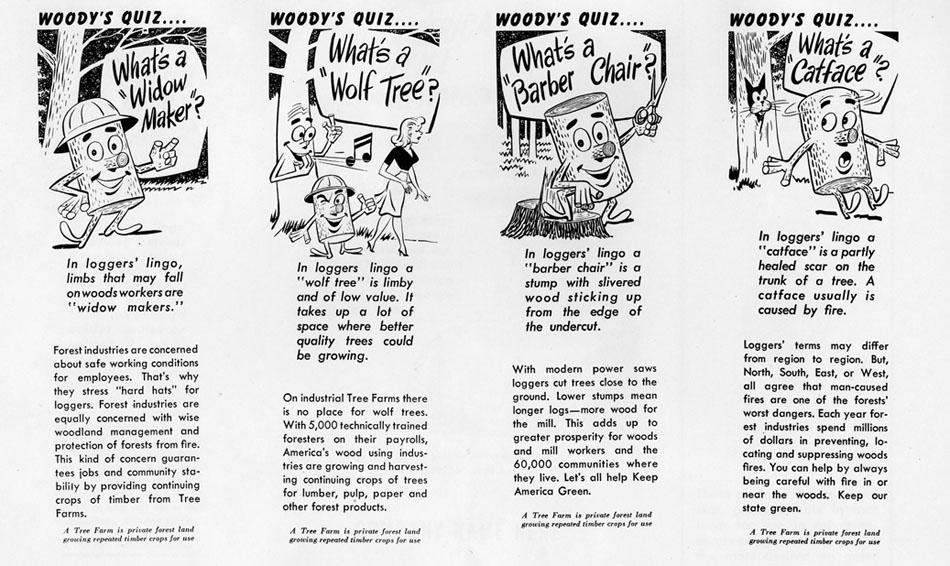
Woody’s “loggers’ lingo” quiz selections, 1954.
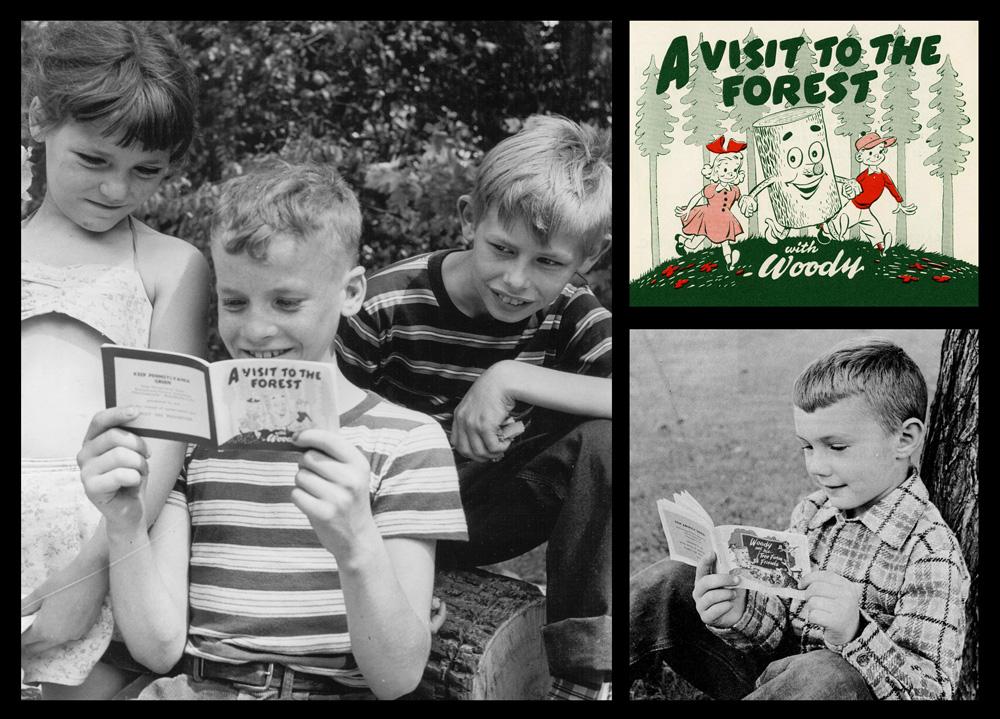
Children reading Woody comic books (see excerpt from “A Visit to the Forest with Woody” below).
Read a short excerpt from two of the Woody comic books: “A Visit to the Forest with Woody” and “Keep America Green.”
For more information on the history of American Forest Products Industries, see the American Forest Institute Collection.
And be sure to stay tuned to Peeling Back the Bark’s series examining Forgotten Forest History Characters, where next month we examine . . . the infamous Guberif.


